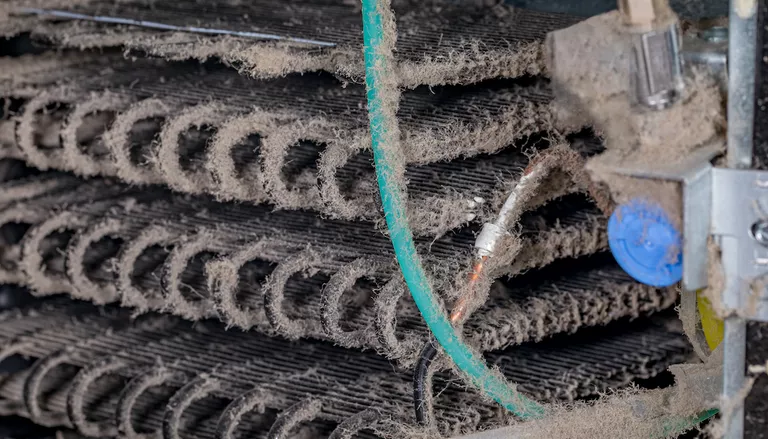Find local pros for your project
Tell us what you’re looking for and we’ll show you pros right for the job, with prices.
Updated
By Nicki Escudero
We all know that a refrigerator that stays cool is essential for safely storing food items. If your refrigerator isn’t cooling (the temperature should be set at 40 °F or below), a few common issues may be causing the problem.
If you’re wondering, “why is my fridge not cooling?” keep reading to see how you can troubleshoot this common fridge problem.
Maybe you recently moved in or moved things around in your kitchen. If the fridge came unplugged, the fix could be as simple as plugging it back in.
You can troubleshoot this issue by plugging other devices into the outlet to see if they turn on. If not, you may have an outlet problem that requires an electrician's expertise.
There may be an issue with the circuit breaker. Because refrigerators are large appliances, they can use a significant amount of electricity. Sometimes, this results in a surge that causes the electricity circuit to overload. When this happens, the circuit breaker’s internal switch changes to prevent an unsafe surge of electricity.
To troubleshoot, open the box containing the circuit board. If the breaker has tripped, you can reset the switch that connects to the refrigerator. See if that fixes the issue.
If the circuit breaker continues to trip, you can unplug the refrigerator and plug it into another outlet. Use an extension cord if necessary. If the refrigerator works in the new outlet, the issue is likely the circuit breaker.
If the circuit breaker has been tripping frequently, you may want to replace the panel. If so, hire a circuit breaker professional near you.
When your refrigerator door isn’t completely closed, that can cause a fridge to stop cooling properly. Some refrigerators will start beeping to warn that the door hasn’t properly been closed.
Another potential door issue may occur when the door gaskets and seals are dirty or damaged. A door that isn’t properly sealed could cause cool air to escape. Inspect the door seal to confirm it’s clean and intact.
If it's dirty, you can use a mixture of hot water and soap to clean the folds with a cotton swab.
Pro tip: To check that the door seal is working properly, place a dollar bill halfway in the door. Close the door on it and attempt to pull the bill out.
If you feel a slight resistance, the door seal is intact. If the bill comes out easily, there may be an issue with the door seal. If the door seal has lacerations, you may want to hire a refrigerator repair professional to replace it.
 Dirty condenser coils and faulty evaporator coils can also cause a refrigerator to malfunction. These coils are the long tubes in the fridge that help it work properly, dissipating the heat absorbed as refrigerant condenses.
Dirty condenser coils and faulty evaporator coils can also cause a refrigerator to malfunction. These coils are the long tubes in the fridge that help it work properly, dissipating the heat absorbed as refrigerant condenses.
They’re usually located at the back or on the bottom of the refrigerator. They're either exposed or covered by a panel you can unscrew to access them.
When coils get dirty from things like pet hair, they can become less efficient. Follow these steps to clean the condenser coils:
The evaporator fan motor blows air over the evaporator coils. After you unplug the fridge and remove the fan panel, make sure the fan isn't damaged or frozen and covered with frost.
If the blades have trouble turning, you may need to replace the fan. You can also use a multimeter to conduct a continuity test on the evaporator fan. Or, hire a refrigerator repair professional to test the fan for you.
Your fridge may not be cooling simply due to a higher temperature setting. Check the temperature control board so the refrigerator is set to less than 40°F.
If the fridge is located near direct sunlight, that could also impact its ability to stay cool.
A blocked vent can also cause cooling issues. Check the vents inside the refrigerator and freezer to make sure no food or other object is blocking them. You should also check to ensure ice and frost aren't covering the vents in your freezer.
If the vents aren’t working even when there are no obstructions, these components may be broken. It's best to hire a refrigerator repair professional to troubleshoot and fix this issue.
Owner's manuals often recommend leaving at least 2 inches of clearance at the top, sides and back of your refrigerator. This allows heat to escape from the appliance so that it stays cool.
If the fridge is too tightly positioned in your kitchen, you may want to move it to a different space with more breathing room.
If your freezer’s working but the fridge isn’t, frost build-up on freezer compartments could be blocking the vents. This could prevent cold air from reaching the refrigerator.
Figure out if your defrost timer is to blame for this issue. If it's not working, you may need to repair or replace it. A pro can also check if the following culprits are to blame:
Here are more reasons why your freezer is working but your fridge isn't.
Proper maintenance can help prevent refrigerator issues. To better maintain your fridge, make sure to:
You may be uncomfortable handling electrical work. Or, you may need help moving your fridge and checking its components. If that's the case, don't hesitate to contact a refrigerator repair professional who can help. Download the Thumbtack app today to hire a fridge repair pro.
Tell us what you’re looking for and we’ll show you pros right for the job, with prices.